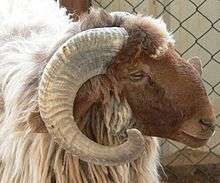Awassi
 | |
| Other names | Egyptian Baladi, Deiri, Syrian, Ausi, Nuami, Gezirieh |
|---|---|
| Country of origin | Saudi Arabia, Jordan, Iraq, Israel, Syria, Lebanon, Palestine, Egypt |
| Distribution | South-West Asia, Syro-Arabian desert |
| Use | Milk, meat, wool |
| Traits | |
| Wool color | White |
| Face color | Brown |
| Notes | |
| Tolerant of extreme temperatures | |
| |
The Awassi (Arabic: عواسي) is a local sheep breed in South-West Asia originated in the Syro-Arabian desert. Other local names can also be Ivesi, Baladi, Deiri, Syrian, Ausi, Ducktales, Nuami or Gezirieh.[1] It is a fat-tailed type and is multi coloured: white with brown head and legs (sometimes also black or brown). The ears are long and drooping.[2]
Habitat
The Awassi is the most prevalent sheep breed in the Arab Countries. The Awassi sheep breed is common in most of the Middle East Countries including Saudi Arabia, Jordan, Iraq, Syria, Lebanon, Israel, Palestine, and Egypt. It is an extremely hardy breed, well adapted over centuries of use to nomadic and more sedentary rural management. The Awassi is the natural or basic breed of sheep for production in these areas and a logical choice as the native or basic breed for any genetic improvement because of its apparent adaptation.
Characteristics

It is used for a range of products; meat, milk and wool. However, this breed is raised primarily for milk.[3] They have unique physiological characteristics such as resistance to many diseases and parasites, walk long distances over pastures for grazing, tolerating extreme temperatures and enduring adverse feeding conditions. It easily adapts to different environments and performs as well as in its native habitat. Awassi sheep are well-adapted to the poor Mediterranean pasture and can compensate for under-nutrition during the dry season by using the stored energy reserves in the fat tail. It has a high mothering ability. Due to its high milk producing potential under harsh conditions, the Awassi breed can be used as a sire breed in improving milk production of many indigenous Asiatic and African breeds. The Awassi breed is known to be the highest milking breed after the East Friesian breed.
Awassi sheep can be kept under a wide range of production systems, from nomadic flocks relying on natural pasture in semi-arid areas where lamb production is the primary products, to intensive dairy flocks where milk and lambs contribute almost equally to the flock gross income, and it is known for its hardiness and adaptability.[4]
References
- ↑ "Awassi". Breeds of Livestock. Oklahoma State University, Dept. of Animal Science. Archived from the original on 2009-03-26. Retrieved 2009-05-14.
- ↑ M. Y. Amin & K. Peters (October 11–13, 2006). "Awassi Sheep Production and the Development of breeding Program Options in Syria" (PDF). Bonn: Humboldt University. Retrieved 2009-05-14.
- ↑ "Awassi/Israel/Iran". Breed Data Sheet. Domestic Animal Diversity Information System. Retrieved 2009-09-09.
- ↑ "Awassi Sheep A Rare Breed of Middle East Origin". Rare Breeds Conservation Society of New Zealand. Retrieved 2009-05-14.
See also
| Wikimedia Commons has media related to Awassi sheep. |